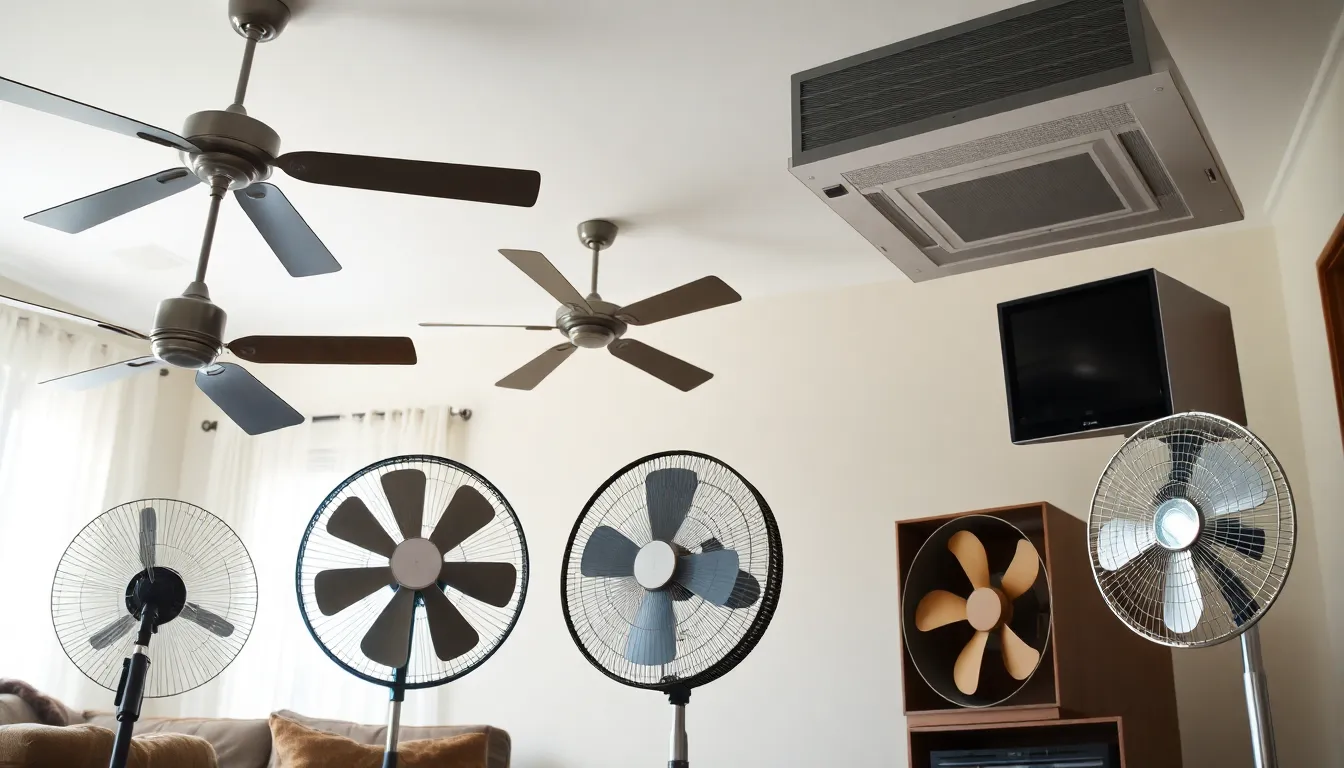In a world where silence is golden, fan noise can feel like a pesky mosquito buzzing in your ear. Whether it’s the whirring of an office fan or the hum of a ceiling fan during a summer heatwave, managing that noise is crucial for maintaining sanity and productivity. Imagine trying to focus on your work or relax at home while your fan sounds like a jet engine preparing for takeoff.
Table of Contents
ToggleUnderstanding Fan Noise Management
Fan noise refers to the sound produced by mechanical fans in various appliances and systems. This noise can vary in intensity and frequency, often causing irritation in residential and professional environments.
What Is Fan Noise?
Fan noise arises from the movement of air caused by fan blades. Different types of fans generate distinct sounds; for example, ceiling fans create a gentle whoosh, while high-speed computer fans produce a higher-pitched whir. These sounds become significant when they disrupt activities like working, studying, or relaxing. The volume and tone of fan noise largely depend on factors like speed, size, and design. Understanding these elements helps identify noise sources and implement effective solutions.
Importance of Managing Fan Noise
Managing fan noise enhances comfort and productivity in various settings. Unwanted noise can distract employees and disrupt concentration, resulting in reduced work efficiency. In homes, excessive noise can impact relaxation and sleep quality. Research indicates that consistent exposure to such disturbances increases stress levels and negatively affects well-being. Implementing effective fan noise management strategies, like using sound-dampening materials or selecting quieter fan models, plays a crucial role in maintaining a peaceful environment.
Common Sources of Fan Noise

Fan noise stems from various factors, with distinct types of fans creating different sound levels. Recognizing these sources aids in effective noise management.
Types of Fans and Their Noise Levels
Ceiling fans produce moderate noise levels, generally designed for quiet operation. Table fans might create noticeable sound depending on their speed settings. Meanwhile, box fans often generate a louder hum due to their robust construction. Additionally, exhaust fans typically emit a steady sound linked to air removal. Each fan type interacts with its environment in unique ways, contributing to its overall noise profile.
Factors Contributing to Fan Noise
Fan blade design plays a critical role in noise generation, with angled blades causing more turbulence. Additionally, fan speed significantly influences sound levels; higher speeds lead to increased noise. The material used in fan construction also impacts sound, with metal fans often being noisier than plastic ones. Furthermore, maintenance affects noise levels; dust accumulation can lead to additional vibrations. Environmental factors, such as room acoustics or fan placement, further shape how noise travels in a space.
Techniques for Fan Noise Management
Managing fan noise involves several strategies that can enhance comfort in various environments. These techniques can be divided into mechanical and electronic solutions.
Mechanical Solutions
Mechanical approaches focus on physical modifications to fans or their environment. Selecting quieter fan models can significantly reduce noise levels. For instance, choosing fans with a higher blade count often leads to smoother airflow and lower noise output. Additionally, positioning fans on soft surfaces, like carpets or rubber mats, minimizes vibrations that contribute to sound. Regular maintenance, such as cleaning blades and lubricating motors, also helps maintain optimal performance and reduces noise. Installing sound-dampening materials around fan units absorbs excess sound, creating a quieter atmosphere.
Electronic Solutions
Electronic methods utilize technology to mitigate fan noise effectively. Smart fans equipped with noise-reduction features allow users to control settings for quieter operation. Implementing variable speed controllers provides flexibility, as lower speeds generate less noise while still maintaining airflow. Sound masking devices can also help; these devices emit sounds that mask or obscure distracting fan noises. Furthermore, using app-controlled fans allows users to adjust settings remotely, catering to individual preferences for sound and airflow. Applying these electronic solutions contributes to a more peaceful environment that supports productivity and relaxation.
Evaluating Fan Noise Management Effectiveness
Evaluating fan noise management effectiveness involves measuring sound levels and assessing performance through specific criteria.
Noise Measurement Methods
Various methods exist to measure fan noise accurately. Sound level meters provide precise decibel readings, capturing noise levels of fans across different settings. In addition, smartphone apps offer a convenient alternative for basic sound measurement. These apps may not be as accurate but provide quick assessments. Furthermore, conducting in-field tests under real operating conditions yields more context-aware results. Placement of microphones helps capture peak noise levels, allowing for comprehensive analysis of sound patterns. Gathering data over time ensures a thorough understanding of noise levels during various fan operations.
Performance Assessment Criteria
Establishing performance assessment criteria is essential for effective fan noise management. Key areas include decibel levels, frequency response, and tonal quality. Decibel levels indicate the intensity of fan noise, helping to categorize acceptable limits. Frequency response analyzes variations across different pitches, revealing potential irritations in sound. Additionally, tonal quality examines whether the fan produces pleasant or unpleasant sounds, impacting user experience. Longevity and reliability also matter, as quieter fans should maintain their performance over time. Comparing these criteria against industry standards ensures that selected fans meet user expectations for noise control.
Effective fan noise management is essential for creating a comfortable and productive environment. By understanding the sources and characteristics of fan noise, individuals can make informed choices about fan selection and placement. Implementing mechanical and electronic strategies can significantly reduce disruptive sounds and enhance overall well-being.
Regular maintenance and the use of sound-dampening materials further contribute to a quieter space. As awareness of the impact of noise on focus and relaxation grows, prioritizing fan noise management will become increasingly important. Embracing these techniques can lead to improved productivity and a more serene atmosphere in both work and home settings.




